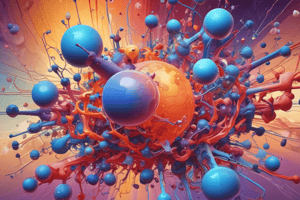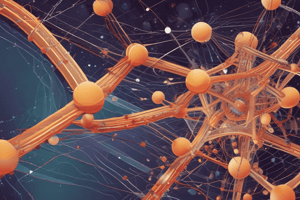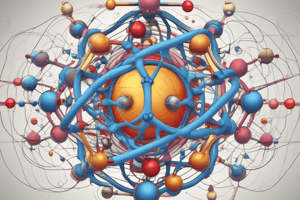Podcast
Questions and Answers
What is matter?
What is matter?
- Invisible substance
- Energy only
- Light particles
- Anything that has mass and occupies space (correct)
List the four states of matter.
List the four states of matter.
Solids, Liquids, Gases, Plasma
Liquids have a definite ______ but no fixed shape.
Liquids have a definite ______ but no fixed shape.
volume
Solids have both definite shape and volume.
Solids have both definite shape and volume.
Match the state of matter with its particle arrangement:
Match the state of matter with its particle arrangement:
What is matter?
What is matter?
Which of the following are states of matter? (Select all that apply)
Which of the following are states of matter? (Select all that apply)
Solids have a definite shape and volume.
Solids have a definite shape and volume.
In solids, particles are tightly packed and only __________ in place.
In solids, particles are tightly packed and only __________ in place.
Match each state of matter with its description:
Match each state of matter with its description:
Study Notes
Introduction to Matter
- Matter is anything with mass and occupies space, making up everything around us.
- Understanding matter is essential to understanding our physical world.
States of Matter
- Solids: Have a definite shape and volume, with particles tightly packed and vibrating in place.
- Liquids: Have a definite volume but no fixed shape, with particles close together and able to move past each other.
- Gases: Have no fixed shape or volume, with particles far apart and moving freely.
- Plasma: High-energy state with ionized particles, found in stars and neon lights.
Properties of Each State
- Shape and Volume: Solids have a fixed shape and volume, liquids have a fixed volume but no shape, and gases have neither.
- Particle Arrangement: Solids have tightly packed particles, liquids have close particles, and gases have far-apart particles.
- Movement of Particles: Solids have vibrating particles, liquids have particles that can move past each other, and gases have freely moving particles.
Changes in States of Matter
- Melting: Changing from solid to liquid.
- Freezing: Changing from liquid to solid.
- Evaporation: Changing from liquid to gas.
- Condensation: Changing from gas to liquid.
- Sublimation: Changing from solid to gas or vice versa.
Examples and Applications
- Everyday Examples: Solids (rocks, tables), liquids (water, oil), gases (air, helium), and plasma (stars, neon lights).
- Real-life Applications: Solids (construction), liquids (transportation), gases (balloons), and plasma (medical tools).
Interesting Facts
- Non-Newtonian Fluids: Liquids that change viscosity when force is applied.
- Fun Experiments: Demonstrating properties of matter, such as creating a lava lamp or making slime.
Introduction to Matter
- Matter is anything with mass and occupies space, making up everything around us.
- Understanding matter is essential to understanding our physical world.
States of Matter
- Solids: Have a definite shape and volume, with particles tightly packed and vibrating in place.
- Liquids: Have a definite volume but no fixed shape, with particles close together and able to move past each other.
- Gases: Have no fixed shape or volume, with particles far apart and moving freely.
- Plasma: High-energy state with ionized particles, found in stars and neon lights.
Properties of Each State
- Shape and Volume: Solids have a fixed shape and volume, liquids have a fixed volume but no shape, and gases have neither.
- Particle Arrangement: Solids have tightly packed particles, liquids have close particles, and gases have far-apart particles.
- Movement of Particles: Solids have vibrating particles, liquids have particles that can move past each other, and gases have freely moving particles.
Changes in States of Matter
- Melting: Changing from solid to liquid.
- Freezing: Changing from liquid to solid.
- Evaporation: Changing from liquid to gas.
- Condensation: Changing from gas to liquid.
- Sublimation: Changing from solid to gas or vice versa.
Examples and Applications
- Everyday Examples: Solids (rocks, tables), liquids (water, oil), gases (air, helium), and plasma (stars, neon lights).
- Real-life Applications: Solids (construction), liquids (transportation), gases (balloons), and plasma (medical tools).
Interesting Facts
- Non-Newtonian Fluids: Liquids that change viscosity when force is applied.
- Fun Experiments: Demonstrating properties of matter, such as creating a lava lamp or making slime.
Studying That Suits You
Use AI to generate personalized quizzes and flashcards to suit your learning preferences.
Description
Learn about the basics of matter, its states, and properties. Understand the characteristics of solids, liquids, gases, and plasma, and how they differ in terms of shape, volume, particle arrangement, and movement.




